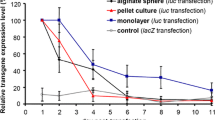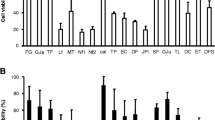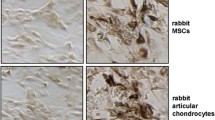Abstract
The menisci are intraarticular fibrocartilaginous structures essential to the normal function of the knee that lack the ability to self-repair. Human meniscal fibrochondrocytes may respond to beneficial genes like human insulin growth factor-1 (hIGF-1) and the meniscal cell may be a feasible donor for gene therapy. To explore this possibility, we amplified the hIGF-1 gene sequence in full length and cloned it into a bicistronic plasmid. This gene was then transfected into cultured human meniscal fibrochondrocytes by the liposome FuGene 6. Green fluorescence was expressed in part of the cells 6 hours after transfection and increased gradually, with a peak concentration of the hIGF-1 in the supernatants to 22.68 ng/mL 56 hours after transfection. Phenotypes of some cells changed and the proliferation accelerated after transfection. Flow cytometry analysis demonstrated upregulation of cell numbers in the G2 and S stages after hIGF-1 gene introduction. We conclude the hIGF-1 gene can be transfected into the human meniscal cell efficiently by liposome and it causes accelerated proliferation and differentiation. Within 10 days after transfection, the cytokine appears to be secreted into supernatants with the bioactivity and promotes the proliferation of the NIH 3T3 cell line.




Similar content being viewed by others
References
Aagaard H, Verdonk R. Function of the normal meniscus and consequences of meniscal resection. Scan J Med Sci Sports. 1999;9:134–140.
Bhargava MM, Hidaka C, Hannafin JA, Doty S, Warren RF. Effects of hepatocyte growth factor and platelet-derived growth factor on the repair of meniscal defects in vitro. In Vitro Cell Dev Biol Anim. 2005;41:305–310.
Brindle T, Nyland J, Johnson DL. The meniscus: review of basic principles with application to surgery and rehabilitation. J Athl Train. 2001;36:160–169.
Capito RM, Spector M. Collagen scaffolds for nonviral IGF-1 gene delivery in articular cartilage tissue engineering. Gene Ther. 2007;14:721–732.
Dupont J, Holzenberger M. Biology of insulin-like growth factors in development. Birth Defects Res C Embryo Today. 2003;69:257–271.
Evans CH, Gouze JN, Gouze E, Robbins PD, Ghivizzani SC. Osteoarthritis gene therapy. Gene Ther. 2004;11:379–389.
Garcia AM, Szasz N, Trippel SB, Morales TI, Grodzinsky AJ, Frank EH. Transport and binding of insulin-like growth factor I through articular cartilage. Arch Biochem Biophys. 2003;415:69–79.
Gelse K, von der Mark K, Schneider H. Cartilage regeneration by gene therapy. Curr Gene Ther. 2003;3:305–317.
Hadaka C, Ibarra C, Hannafin JA, Torzilli PA, Quitoriano M, Jen SS. Warren RF, Crystal RG. Formation of vascularized meniscal tissue by combining gene therapy with tissue engineering. Tissue Eng. 2002;8:93–105.
Heckmann TP, Barber-Westin SD, Noyes FR. Meniscal repair and transplantation: indications, techniques, rehabilitation, and clinical outcome. J Orthop Sports Phys Ther. 2006;36:795–814.
Hellgren I, Drvota V, Pieper R, Enoksson S, Blomberg P, Islam KB, Sylvén C. Highly efficient cell-mediated gene transfer using non-viral vectors and FuGene6: in vitro and in vivo studies. Cell Mol Life Sci. 2000;57:1326–1333.
Itoh K, Suzuki S, Kuroda T. Effects of local administration of insulin-like growth factor-I on mandibular condylar growth in rats. J Med Dent Sci. 2003;50:79–85.
Johnson TC, Evans JA, Gilley JA, DeLee JC. Osteonecrosis of the knee after arthroscopic surgery for meniscal tears and chondral lesions. Arthroscopy. 2000;16:254–261.
Kessner K, Fahlgren A, Ross I, Andersson B. Simultaneous changes in bone mineral density and articular cartilage in a rabbit meniscectomy model of knee osteoarthrosis. Osteoarthritis Cartilage. 2000;8:197–206.
Kollias SL, Fox JM. Meniscal repair. Where do we go from here? Clin Sports Med. 1996;15:621–630.
Lee PD, Giudice LC, Conover CA, Powell DR. Insulin-like growth factor binding protein-1: recent findings and new directions. Proc Soc Exp Biol Med. 1997;216:319–357.
Loeser RF, Shanker G. Autocrine stimulation by insulin-like growth factor 1 and insulin-like growth factor 2 mediates chondrocyte survival in vitro. Arthritis Rheum. 2000;43:1552–1559.
Madry H, Cucchiarini M, Kaul G, Kohn D, Terwilliger EF, Trippel SB. Menisci are efficiently transduced by recombinant adeno-asociated virus vectors in vitro and in vivo. Am J Sports Med. 2004;32:1860–1865.
Madry H, Trippel SB. Efficient lipid-mediated gene transfer to articular chondrocytes. Gene Ther. 2000,7:286–291.
McDermott ID, Amis AA. The consequences of meniscectomy. J Bone Joint Surg Br. 2006;88:1549–1556.
Nixon AJ, Saxer RA, Brower-Toland BD. Exogenous insulin-like growth factor-I stimulates an autoinductive IGF-1 autocrine/paracrine response in chondrocytes. J Orthop Res. 2001;19:26–32.
Ohan J, Gilbert MA, Leseche G, Panis Y, Midoux P, Drouet L. Nonviral gene transfer into primary cultures of human and porcine mesothelial cells. In Vitro Cell Dev Biol Anim. 2001;37:402–407.
Phillips JE, Gersbach CA, Garcia AJ. Virus-based gene therapy strategies for bone regeneration. Biomaterials. 2007;28:211–229.
Roeddecker K, Nagelschmidt M, Koebke J, Guensche K. Meniscal healing: a histological study in rabbits. Knee Surg Sports Traumatol Arthrosc. 1993;1:28–33.
Rogachefsky RA, Dean DD, Howell DS, Altman RD. Treatment of canine osteoarthritis with insulin-like growth factor-1 (IGF-1) and sodium pentosan polysulfate. Osteoarthritis Cartilage. 1993;1:105–114.
Takahashi T, Ogasawara T, Kishimoto J, Liu G, Asato H, Nakatsuka T, Uchinuma E, Nakamura K, Kawaguchi H, Chung UI, Takato T, Hoshi K. Synergistic effects of FGF-2 with insulin or IGF-1 on the proliferation of human auricular chondrocytes. Cell Transplant. 2005;14:683–693.
Tomita T, Hashimoto H, Tomita N, Morishita R, Lee SB, Hayashida K, Nakamura N, Yonenobu K, Kaneda Y, Ochi T. In vivo direct gene transfer into articular cartilage by intraarticular injection mediated by HVJ (Sendai virus) and liposomes. Arthritis Rheum. 1997;40:901–906.
Tumia NS, Johnstone AJ, Regional regenerative potential of meniscal cartilage exposed to recombinant insulin-like growth factor-1 in vitro. J Bone Joint Surg Br. 2004;86:1077–1081.
Witlox MA, Lamfers ML, Wuisman PI, Curiel DT, Siegal GP. Evolving gene therapy approaches for osteosarcoma using viral vectors: review. Bone. 2007;40:797–812.
Ye C, Deng Z, Li B. Effect of three growth factors on proliferation and cell phenotype of human fetal meniscal cells [in Chinese]. Zhongguo Xiu Fu Chong Jian Wai Ke Za Zhi. 2007;21:1137–1141.
Acknowledgments
We thank Dr. Xiaokui Hou for assistance with the manuscript. We also thank Dr. Guanzhen Yang and Dr. Xiangfu Wu for technical assistance.
Author information
Authors and Affiliations
Corresponding author
Additional information
Three of the authors (Hai-ning Zhang, Ping Leng and Ying-zhen Wang) received funding from the National Natural Science Foundation of China (No. 30801167).
Each author certifies that he or she has no commercial associations (eg, consultancies, stock ownership, equity interest, patent/licensing arrangements, etc) that might pose a conflict of interest in connection with the submitted article.
Each author certifies that his or her institution has approved the human protocol for this investigation, that all investigations were conducted in conformity with ethical principles of research, and that informed consent for participation in the study was obtained.
This work was performed at The Affiliated Hospital of Tsingtao University, China.
About this article
Cite this article
Zhang, Hn., Leng, P., Wang, Yz. et al. Treating Human Meniscal Fibrochondrocytes with hIGF-1 Gene by Liposome. Clin Orthop Relat Res 467, 3175–3182 (2009). https://doi.org/10.1007/s11999-009-0870-2
Received:
Accepted:
Published:
Issue Date:
DOI: https://doi.org/10.1007/s11999-009-0870-2




